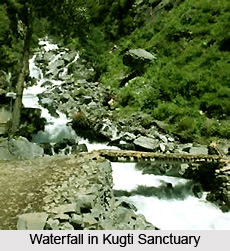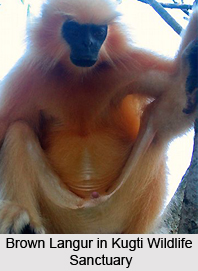 Kugti Wildlife Sanctuary is existent in Chamba District of the northern Indian state of Himachal Pradesh, close to the city of Bharmour and is said to be the second largest wildlife sanctuary in this state. It is based at an altitude measuring about 2, 195 metres to 5, 040 metres above mean sea level. A great forest belt flanks this sanctuary on its western side and the sanctuary is filled with a gently varying landscape, with a beautiful combination of flora and fauna. A number of water sources are available in this area, most of which are born from glaciers. The notable Manimahesh Temple is also present inside Kugti Wildlife Sanctuary which is thronged by innumerable pilgrims every year. The area enclosed by the sanctuary is about 378 square kilometres and the sanctuary is based at a distance of nearly 87 kms away from Chamba, 15 kms away from Kugti village and 30 kms away from Bharmour city. It was established in the year 1962.
Kugti Wildlife Sanctuary is existent in Chamba District of the northern Indian state of Himachal Pradesh, close to the city of Bharmour and is said to be the second largest wildlife sanctuary in this state. It is based at an altitude measuring about 2, 195 metres to 5, 040 metres above mean sea level. A great forest belt flanks this sanctuary on its western side and the sanctuary is filled with a gently varying landscape, with a beautiful combination of flora and fauna. A number of water sources are available in this area, most of which are born from glaciers. The notable Manimahesh Temple is also present inside Kugti Wildlife Sanctuary which is thronged by innumerable pilgrims every year. The area enclosed by the sanctuary is about 378 square kilometres and the sanctuary is based at a distance of nearly 87 kms away from Chamba, 15 kms away from Kugti village and 30 kms away from Bharmour city. It was established in the year 1962.
Flora of Kugti Wildlife Sanctuary
Various types of medicinal plants can be noticed in Kugti Wildlife Sanctuary which are covered under Western Mixed Coniferous Forests, Moist Deodar Forests and so on. Herbs like Dhup and Karu are also existent here. Medicinal plants including Ativisha, Chaora, Morel Mushroom, Himalayan Mayapple, etc. are also observed in this sanctuary.

Fauna of Kugti Wildlife Sanctuary
Snow Leopard, Musk Marten, Ibex, Leopard, Brown Langur, Himalayan Tahr, Common Cat, Himalayan Yellow-Throated Fox, Deer, Indian Serow, etc. are some of the wild animals which are provided refuge inside the grounds of Kugti Wildlife Sanctuary. There are also plenty of birds which survive in this region including Red-Billed Babbler, Snow Cock, Monal, Redvented Bulbul, Crested Bunting, Great Hill Barbet, Black Bulbul, Greyhead Bunting, Jungle Babbler, Ghoral, White Cheeked Bulbul and much more species of birds. Many endangered animals have also been preserved here.
The best time to pay visit to Kugti Wildlife Sanctuary is between the period from April and June and also the time between October and November. Trekking and camping activities are often organised in this wildlife sanctuary, particularly during the summer season.



















